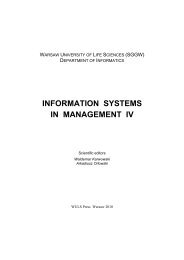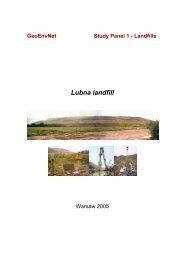ACTA SCIENTIARUM POLONORUM - SGGW
ACTA SCIENTIARUM POLONORUM - SGGW
ACTA SCIENTIARUM POLONORUM - SGGW
Create successful ePaper yourself
Turn your PDF publications into a flip-book with our unique Google optimized e-Paper software.
92 M. Renigier-Biłozor, R. Wiśniewskiper, the following factors contribute to the inefficiency and ineffectiveness of real estatemarkets:– significant variations in the quantity of available information, subject to the type ofthe analyzed market (region),– complex methods of data description (differences in the scale of attribute description)– the same attribute can be described in a variety of ways using different evaluationscales,– significant differences between real estates (no two real estates are identical),– various criteria for using real estate (every real estate can be used and managed in avariety of ways),– lack of comprehensive information (due to the lack of homogenous systems for gatheringreal estate data which results in limited and incomplete knowledge about realestate and market prices),– inaccurate and “fuzzy” character of real estate data (caused by stochastic factorswhich reflect random processes that escape the generally acknowledged cause-andeffectmarket relationship),– absence of homogenous functional dependencies between real estate attributes,– decision-making strategies represented by the value, function and method of real estatemanagement.According to the authors, popular analytical methods (mostly statistical) are relativelyineffective in weak-form efficient real estate markets. The preferred methods and proceduresshould account for the following defects in real estate data: absence of data, smallnumber of transactions, significant variations in attribute coding, non-linear correlationsbetween the analyzed data and the type of the underlying market. The applied methodsshould support market analysis at the potential (theoretical) and actual (applied) level.The below solutions (Table 4) that rely on the rough set theory may offer an effectivealternative to popular analytical methods. References to detailed studies are indicated inparentheses.The process of managing real estate resources is problematic due to the specificityof real estate information. Owing to the complexity and diversity of data sets, the decision-makingprocess in managing the resources of the largest property owners in Poland,such as municipalities or Polish State Railway companies, is wrought with problems.The greater the responsibility, the more difficult this process which affects not only theowner’s financial performance but also the spatial, economic and social development ofurban areas. The authors have concluded that the application of the rough set theory inreal estate market analyses may deliver positive results (compare with Table 4). As demonstratedby Table 4, the use of the rough set theory for developing decision trees couldenhance the effectiveness of the decision-making process in real estate management.The rough set theory can also be applied in real estate appraisal on markets characterizedby quantitative and qualitative defects. As demonstrated by the results of studiesreferenced in Table 4, market analyses can produce reliable results even when the numberof transactions is small and when different attribute registration methods are applied. Theprocedure proposed by the authors does not require the development of complex models,preliminary analyses or the adjustment of the available data sets. In the approach basedon the rough set theory, decisions are made based on “raw data” in line with the principlesActa Sci. Pol.
















